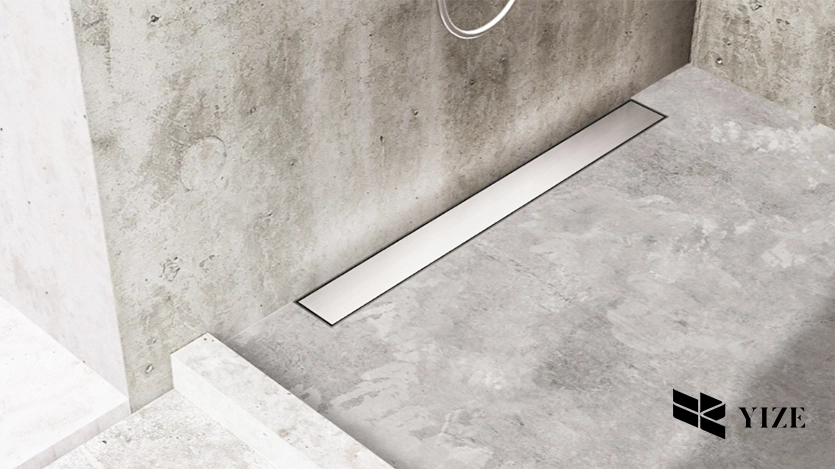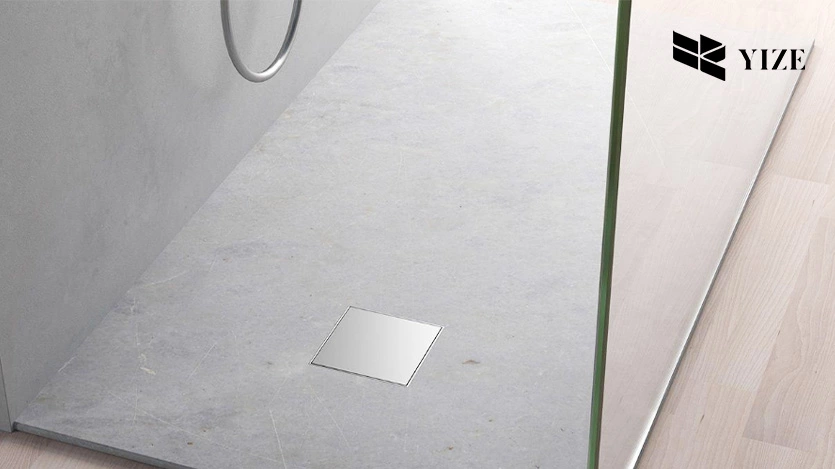When remodeling a bathroom or planning a new shower design, one important yet often overlooked decision is the type of drain to install. Your two main options? A linear shower drain or a point shower drain. While both serve the same basic purpose, directing water out of the shower, they do so in very different ways. Each has its own unique style, cost, installation method, and maintenance needs.
So, how do you know which one is best for your space, your style, and your budget?
In this guide, we’ll break down the differences between linear drain showers and point drain showers, helping you make an informed and confident decision.
I. What is a Linear Shower Drain?

Linear shower drains are sleek, slim drains that are usually placed along one wall or the entrance of your shower. They create a smooth, single-plane slope, making them a perfect fit for modern, minimalist designs. These drains not only look great but also help keep your shower space clean and stylish!
Linear Shower Drain Pros and Cons
| Pros | Cons |
| Sleek, modern look | Can be a bit expensive |
| Ideal for curbless or barrier-free showers | Complex installation |
| Easier tiling options due to a single slope | Requires regular maintenance to prevent clogging |
II. What is a Point Shower Drain?

A point shower drain is the classic square or round drain often found in the center of a shower floor. It’s nice and compact, and you’ll usually spot it at the lowest point where the shower pan slopes down from all four sides.
Point Shower Drain Pros and Cons
| Pros | Cons |
| Budget friendly | Requires a complex slope |
| Easy to installAvailable in various sizes and designs | Not ideal for large or curbless showers |
III. Linear Shower Drains & Point Shower Drains: A Side-by-Side Comparison
Now that you know what a point and linear floor drain for shower is, let’s do a side-by-side comparison to help you decide which one you should go for.
1. Installation
The main difference in both drain types is the installation. Point drains require a four-way slope toward the center, which can be tricky and time-consuming.
However, for a linear shower drain installation, you need a simple one-directional slope, making it ideal for larger tiles and a cleaner aesthetic. Moreover, a linear shower drain placement can be on the wall, center, or entrance, offering more flexibility during design.
2. Aesthetic Appeal
If you care about your space looking great, the type of drain you choose can really make a difference! A linear drain for shower offers that sleek, spa-like vibe that’s so popular in high-end designs.
On the other hand, point shower drains might be less eye-catching, but you can personalize them with fun decorative grates to add a unique touch!
3. Cost
When it comes to the cost, point shower drains are clearly a better option, as you can get them installed for under $400. However, linear shower drains can significantly increase costs due to the specialized installation and waterproofing requirements. So, you can expect to pay anywhere between $500 and $1000.
IV. Maintenance and Cleaning
Point drains are easier to clean with standard drain brushes. Linear drains, on the other hand, may require periodic removal of the grate and debris filter to clean thoroughly.
While both can be kept in good condition with regular maintenance, linear drains can become clogged more easily due to their longer channel.
Best Use Cases
If you have a traditional shower that is small or medium in size, a point shower drain is the ideal choice. But, for large, modern, and curbless showers, linear drains are the best.
However, keep in mind that if you’re designing a walk-in or ADA-compliant shower, an adjustable linear shower drain offers better water drainage and tile alignment options.
V. Which One to Choose?
Deciding between a linear shower drain and a point shower drain comes down to your priorities: budget, aesthetics, ease of maintenance, and the type of shower you’re designing.
Here’s a quick guide to help you decide:
| Criteria | Best Choice | Why |
| Budget-friendly | Point Shower Drain | Low material and labor cost |
| Aesthetic | Linear Shower Drain | Sleek and minimalist design |
| Small Shower Space | Point Shower Drain | Compact |
| Large Shower Space | Linear Shower Drain | Best drainage for large areas |
| Maintenance | Point Shower Drain | Easy to clean and unclog |
| Curbless Shower | Linear Shower Drain | One directional slope |
VI. Conclusion
When it comes to choosing between linear or point shower drains, the right choice really depends on your budget, style preferences, and shower design. Point shower drains are great for those sticking to traditional layouts and tight budgets, while linear shower drains offer elegance, accessibility, and visual aesthetics at a higher price point.
In this guide we have rounded up the pros, cons, and differences between both shower drain types. So, take your time to evaluate both types before deciding. And, if you want to get an idea on the different types of drain designs, check out our collection of premium drains.
Frequently Asked Questions
Q1: Can I install a linear shower drain in a small shower?
Yes, but it’s most beneficial in larger or curbless showers. In tight spaces, the extra cost may not be justified unless you want a very specific look.
Q2: Are linear drains harder to install?
Yes, they require precise slope planning and waterproofing. Hiring a professional is highly recommended to avoid water pooling and leakage.
Q3: Do linear drains clog more easily than point drains?
They can, due to the length of the channel. However, many models come with removable strainers to make cleaning easier.
Q4: What type of drain is best for a curbless shower?
A linear shower drain is ideal for curbless and accessible showers because it allows for a single slope, minimizing water runoff issues.
Q5: Is one drain type more durable than the other?
Both drain types are highly durable when installed correctly and made from quality materials like stainless steel or brass. Durability largely depends on the quality of maintenance and installation.
